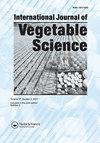茄子品种嫁接野生和栽培砧木在青枯病地里的表现
IF 1.1
Q2 Agricultural and Biological Sciences
引用次数: 0
摘要
摘要在热带和湿润亚热带条件下,细菌性枯萎病(BW)会导致茄子(Solanum melongena L.)产量的广泛损失。将商业品种嫁接到选定的砧木上是控制枯萎病的有效方法,而不需要大量育种来开发抗性品种。在人工设置的侵染床中,筛选了野生和栽培茄子基因型对BW病的耐受性。托尔维姆菌各两株。基因型(BCB ST 1和IARI ST 1)和栽培品种“Utkal Anushree”和“Utkal Madhuri”被确定为最相容(嫁接成活率高)的砧木。将两个广泛栽培的易感品种‘Bidhan Suphala’和‘Bidhan Supreme’作为接穗嫁接到砧木上,测定了嫁接植株在侵染青枯病的实验和大田的生殖生长、果实品质和病害发生率。嫁接植株虽然死亡率低、产量高,但果实品质没有得到改善。龙葵与栽培砧木相比,移栽植株在产量和经济上表现出一定的负面影响,表明移栽后相容性降低。嫁接在栽培砧木“Utkal Anushree”上的“Bidhan Suphala”产量和经济效益均高于嫁接在野生砧木上的“Bidhan Suphala”。可作为嫁接防治茄子枯萎病的有效砧木。将栽培品种嫁接到野生品种的砧木上,可提高产量,延长收成,有效减少BW病造成的作物损失。本文章由计算机程序翻译,如有差异,请以英文原文为准。
Performance of eggplant cultivars grafted on wild and cultivated rootstocks in bacterial wilt infected field
ABSTRACT Bacterial wilt (BW) causes extensive loss in yield of eggplant (Solanum melongena L.) under tropical and humid subtropical conditions. Grafting commercial cultivars onto selected rootstocks is an effective approach to control wilt disease without requiring extensive breeding to develop resistant varieties. Wild and cultivated eggplant genotypes were screened for tolerance to BW disease (Ralstonia solanacearum Biovar IIIA) in artificially created infested beds. Two each of S. torvum Sw. genotypes (BCB ST 1 and IARI ST 1) and cultivated varieties ‘Utkal Anushree’ and ‘Utkal Madhuri’ were identified as most compatible (graft survival was high) rootstocks. Two widely cultivated, susceptible cultivars, ‘Bidhan Suphala’ and ‘Bidhan Supreme’ were grafted as scions on rootstocks and reproductive growth, fruit quality and disease incidence of grafted plants in the bacterial wilt infected experimental and grower fields determined. Although grafted plants had lower mortality and higher yield, fruit quality was not improved. Solanum torvum Sw.-grafted plants exhibited some negative effects on yield and economics compared to cultivated rootstocks, indicating reduced post-transplant compatibility. The ‘Bidhan Suphala’ grafted on cultivated rootstock ‘Utkal Anushree’ had the highest yield and economic return than those grafted on wild rootstocks. ‘Utkal Anushree’ could be effectively used as a rootstock for controlling eggplant wilt through grafting. Grafting eggplant cultivars on rootstock of a cultivated variety over wild species increased yield, extended the harvest and was effective in reducing crop loss caused by BW disease.
求助全文
通过发布文献求助,成功后即可免费获取论文全文。
去求助
来源期刊

International Journal of Vegetable Science
Agricultural and Biological Sciences-Plant Science
CiteScore
3.10
自引率
0.00%
发文量
30
期刊介绍:
The International Journal of Vegetable Science features innovative articles on all aspects of vegetable production, including growth regulation, pest management, sustainable production, harvesting, handling, storage, shipping, and final consumption. Researchers, practitioners, and academics present current findings on new crops and protected culture as well as traditional crops, examine marketing trends in the commercial vegetable industry, and address vital issues of concern to breeders, production managers, and processors working in all continents where vegetables are grown.
 求助内容:
求助内容: 应助结果提醒方式:
应助结果提醒方式:


